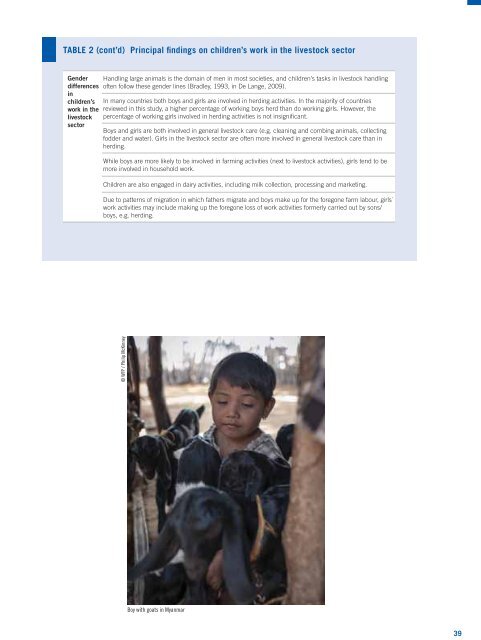Children’s work in the livestock sector: Herding and beyond
Children’s work in the livestock sector: Herding and beyond
Children’s work in the livestock sector: Herding and beyond
Create successful ePaper yourself
Turn your PDF publications into a flip-book with our unique Google optimized e-Paper software.
TABLE 2 (cont’d) Pr<strong>in</strong>cipal f<strong>in</strong>d<strong>in</strong>gs on children’s <strong>work</strong> <strong>in</strong> <strong>the</strong> <strong>livestock</strong> <strong>sector</strong><br />
Gender<br />
differences<br />
<strong>in</strong><br />
children’s<br />
<strong>work</strong> <strong>in</strong> <strong>the</strong><br />
<strong>livestock</strong><br />
<strong>sector</strong><br />
H<strong>and</strong>l<strong>in</strong>g large animals is <strong>the</strong> doma<strong>in</strong> of men <strong>in</strong> most societies, <strong>and</strong> children’s tasks <strong>in</strong> <strong>livestock</strong> h<strong>and</strong>l<strong>in</strong>g<br />
often follow <strong>the</strong>se gender l<strong>in</strong>es (Bradley, 1993, <strong>in</strong> De Lange, 2009).<br />
In many countries both boys <strong>and</strong> girls are <strong>in</strong>volved <strong>in</strong> herd<strong>in</strong>g activities. In <strong>the</strong> majority of countries<br />
reviewed <strong>in</strong> this study, a higher percentage of <strong>work</strong><strong>in</strong>g boys herd than do <strong>work</strong><strong>in</strong>g girls. However, <strong>the</strong><br />
percentage of <strong>work</strong><strong>in</strong>g girls <strong>in</strong>volved <strong>in</strong> herd<strong>in</strong>g activities is not <strong>in</strong>significant.<br />
Boys <strong>and</strong> girls are both <strong>in</strong>volved <strong>in</strong> general <strong>livestock</strong> care (e.g. clean<strong>in</strong>g <strong>and</strong> comb<strong>in</strong>g animals, collect<strong>in</strong>g<br />
fodder <strong>and</strong> water). Girls <strong>in</strong> <strong>the</strong> <strong>livestock</strong> <strong>sector</strong> are often more <strong>in</strong>volved <strong>in</strong> general <strong>livestock</strong> care than <strong>in</strong><br />
herd<strong>in</strong>g.<br />
While boys are more likely to be <strong>in</strong>volved <strong>in</strong> farm<strong>in</strong>g activities (next to <strong>livestock</strong> activities), girls tend to be<br />
more <strong>in</strong>volved <strong>in</strong> household <strong>work</strong>.<br />
Children are also engaged <strong>in</strong> dairy activities, <strong>in</strong>clud<strong>in</strong>g milk collection, process<strong>in</strong>g <strong>and</strong> market<strong>in</strong>g.<br />
Due to patterns of migration <strong>in</strong> which fa<strong>the</strong>rs migrate <strong>and</strong> boys make up for <strong>the</strong> foregone farm labour, girls´<br />
<strong>work</strong> activities may <strong>in</strong>clude mak<strong>in</strong>g up <strong>the</strong> foregone loss of <strong>work</strong> activities formerly carried out by sons/<br />
boys, e.g. herd<strong>in</strong>g.<br />
© WFP / Philip McK<strong>in</strong>ney<br />
Boy with goats <strong>in</strong> Myanmar<br />
39


